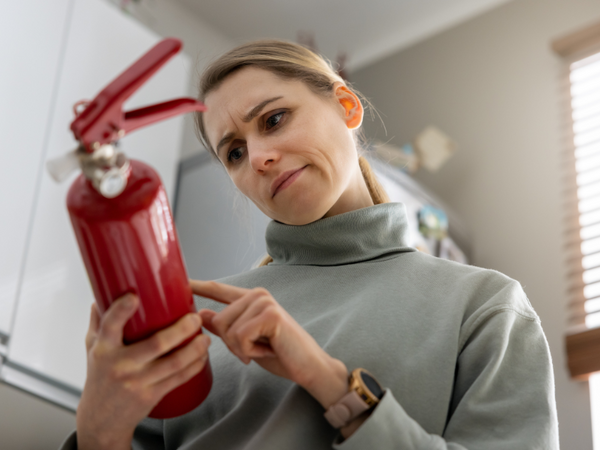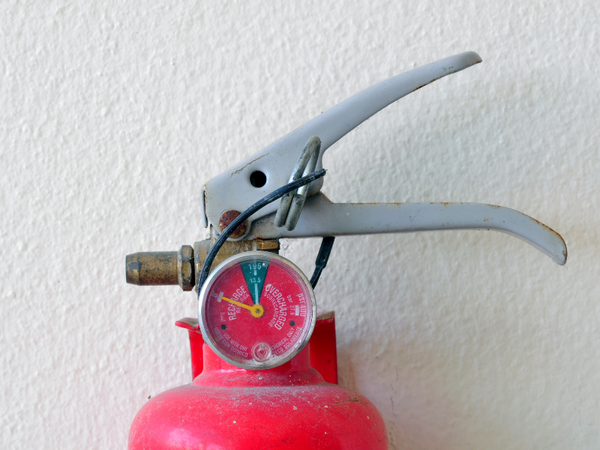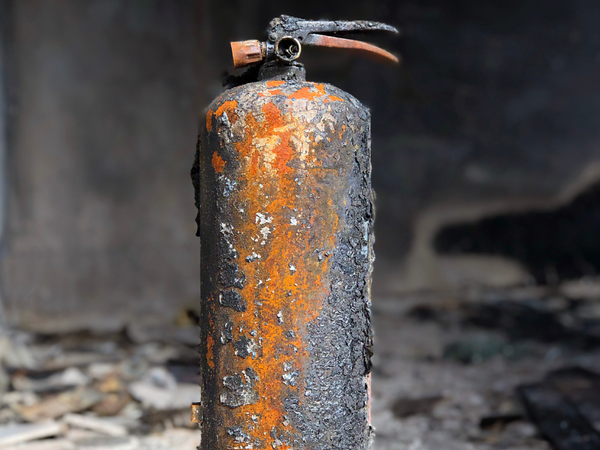Where you put your smoke detectors matters just as much as installing them. Proper placement makes sure they can detect...
Fire extinguishers are a crucial part of any fire safety plan. They help you quickly put out a fire before it gets out of control. However, like other safety tools, fire extinguishers don’t last forever.
In this guide, we’ll explore how fire extinguishers work, why they expire, and how to tell if yours is. Plus, we'll give you tips on what to do with expired extinguishers and alternatives you can use.
How Do Fire Extinguishers Work?

In general, fire extinguishers work by either cooling the heat, cutting off the fuel, or removing the oxygen the fire needs to keep burning. The extinguisher has two main parts inside: an extinguishing agent and a propellant. The extinguishing substance helps stop the fire, while the propellant is a pressurized chemical that forces the substance out when you press the handle.
Fire extinguishers are made of strong steel because the propellant inside is under high pressure. This helps prevent the extinguisher from exploding. At the top, there's a small container with compressed gas and a valve that locks it in place. The valve opens when you pull the safety pin and squeeze the handle. This lets the gas escape, pushing the extinguishing agent out of the nozzle with a lot of force.
Take note fire extinguishers generally work like this. But the exact mechanism depends on the type of extinguisher you have. Let’s take a look at them in detail below:
Water Fire Extinguishers
A water fire extinguisher works by cooling down the fuel. This extinguishes the fire quickly. As its name suggests, it releases water, which lowers the fuel’s temperature. When you squeeze the lever, the high-pressure gas canister gets punctured. The gas is released into the tank, pushing the water out with enough force to put out the fire from a safe distance.
Since it works by cooling the fire, a water extinguisher is best used on Class A fires. These fires involve solid materials like paper, wood, or fabric. Most Class A fire extinguishers also use water. However, it shouldn’t be used on electrical, grease, metal, and flammable liquid fires because water can make them worse.
Water Mist Fire Extinguishers
A water mist fire extinguisher releases deionized water in tiny mist particles through a special nozzle. These tiny droplets create a mist curtain that cools the fire and reduces the oxygen. Heat and oxygen are components of the fire triangle, so removing them from the equation extinguishes the fire.
Water mist extinguishers are also useful for electrical fires or fires involving sensitive items like servers, books, or fabrics. The mist leaves extremely little to no residue, so you can use them on delicate items without damaging them.
Wet Chemical Fire Extinguishers
Wet chemical fire extinguishers are specially designed for Class K fires (also known as grease fires). They usually contain potassium acetate, potassium carbonate, potassium citrate, or a combination of the said chemicals.
When used, the extinguisher sprays a fine mist of wet chemicals through a special nozzle. The mist reacts with the fats or oils in the fire and forms a soapy layer that cools and suffocates the flames. This layer also prevents the fire from reigniting.
Powder Fire Extinguisher
A powder fire extinguisher works by releasing a fine powder made of substances like sodium bicarbonate, potassium bicarbonate, or monoammonium phosphate. In particular, the powder spreads over the fire and separates the fuel from the oxygen. The powder also protects objects from heat and prevents the fire from reigniting.
Powder fire extinguishers are effective for many fire types, including electrical and Class B fires. Plus, Class D fire extinguishers are made of specialized dry powder. However, using them can be tricky because you might inhale the powder. So, we recommend wearing a mask when using them.
Foam Fire Extinguisher
A foam fire extinguisher cools the fuel and creates a barrier between it and the flames. When used, the extinguisher releases a foamy substance that spreads over the fire's surface. This foam cuts off the oxygen supply and smothers the flames.
The foam also cools the fuel, which prevents the fire from reigniting. Foam extinguishers are particularly effective on fires caused by flammable liquids. It’s because they can spread over the surface of the liquid, seal off the fire, and prevent it from spreading.
Carbon Dioxide Fire Extinguisher
A carbon dioxide (CO2) fire extinguisher works by taking away the oxygen the fire needs to burn. It releases carbon dioxide gas, which displaces the oxygen and puts the fire out. CO2 also cools the fire because the gas is extremely cold.
One of the most noticeable features of a carbon dioxide fire extinguisher is the large, black, cone-shaped horn at the end. This helps the gas expand and cool down before it reaches the fire. The horn is also designed to prevent blowing air onto the fire, which could make it worse. CO2 extinguishers are especially useful for Class C fires because they don’t leave any residue behind. However, they’re not ideal for Class D fires.
Do Fire Extinguishers Expire?

Yes, fire extinguishers expire. But they don’t have fixed expiration dates. Instead, their lifespan depends on several factors like the following:
- Type of fire extinguisher
- Whether it is portable, rechargeable, or disposable
- The maintenance it requires
- Manufacturing date
- Manufacturer's guidelines for replacement
According to the International Fire and Safety Journal, a well-maintained fire extinguisher lasts 10 to 12 years. However, certain models may become outdated as regulations change or technology improves. In general, disposable fire extinguishers should be replaced every 12 years, while rechargeable ones have to be recharged every six years.
Testing is also essential in keeping your fire extinguishers in top shape. According to the National Fire Protection Association (NFPA), fire extinguishers should be visually inspected once a month. You should also replace or service an extinguisher if you notice the following:
- Dents
- Broken pin
- Loose handle or hose
- Rust or corrosion
- Cracked hose
- Low pressure
Can a Fire Extinguisher Expire Before Its Expiration Date?

Yes, a fire extinguisher can expire before its expiration date. The usual lifespan of an extinguisher is 10 to 12 years. Some fire extinguishers may be ineffective in less than 10 years.
Fire extinguishers can get damaged, lose pressure, or leak over time, making them less effective. These issues aren’t always obvious, so check your extinguisher regularly. Even if the gauge shows it's full, internal damage can occur. The chemicals inside, especially in dry chemical extinguishers, can also settle or dry up. This can clog the nozzle and stop the extinguisher from working when needed.
Why Do Fire Extinguishers Expire?

Fire extinguishers expire because they rely on pressure to work. Over time, that pressure decreases, making them less effective when needed. That's why most extinguishers have a pressure gauge.
The extinguisher has enough pressure if the needle is in the green zone. But once it moves into the red, the extinguisher isn’t at full strength. How long the pressure lasts depends on the type and size of the extinguisher. Manufacturers usually provide a lifespan and guidelines to make sure your extinguisher stays in top shape.
How to Tell if Your Fire Extinguisher Is Expired

Like other fire prevention tools, fire extinguishers don’t last forever. Here’s how to tell if your fire extinguisher is expired:
1. Check the Manufacturing Date
Start by looking for a manufacturer’s label or stamp on your fire extinguisher. This should show the manufacturing date. Most fire extinguishers last between 10 and 12 years, depending on the type and brand. If your extinguisher has passed this date, it’s time to replace it.
2. Inspect the Pressure Gauge
Most fire extinguishers have pressure gauges that check whether they have the right pressure. You want the needle to be in the green zone. If the needle is in the red zone (either too low or too high), the extinguisher might not work. If this happens, bring it to a technician to recharge or replace it.
3. Look for Physical Damages
Check your fire extinguisher for any signs of damage, such as dents, rust, cracks, or leaks. These issues can make the extinguisher less effective or dangerous. If you notice any of these problems, it’s best to replace the extinguisher or have a professional inspect it.
4. Check the Tamper Seal
The tamper seal is a small plastic or metal seal that indicates the extinguisher hasn’t been used or tampered with. If the seal is broken or missing, the extinguisher is likely used or compromised.
What Happens When Fire Extinguishers Expire?

Fire extinguishers become unreliable when they expire. Over time, the rubber seal between the cylinder and valve can wear out. If your extinguisher is exposed to heat or extreme conditions, this can happen faster and lead to leaks. If the valve stem is damaged, the extinguisher may also fail to release the extinguishing agent.
Regular servicing helps prevent issues like leaks or damaged parts. Fire extinguishers can also expire because some older models may no longer meet modern safety standards. If parts are no longer available or the extinguisher can’t be serviced, it’s time to replace it.
Do Out-Of-Date Fire Extinguishers Still Work?

Out-of-date fire extinguishers won’t work, and they’re dangerous to use. Over time, the chemicals inside break down, the pressure decreases, and the nozzle gets clogged. These issues prevent the fire extinguisher from discharging when you need it most. Imagine grabbing an extinguisher in an emergency, only to find it can't put out the fire.
Although fire extinguishers don't have fixed expiration dates, they need maintenance. Some need to be recharged after a certain amount of time. Older extinguishers may need to be replaced. Regular inspections by a qualified fire safety company can help determine if your extinguisher needs to be recharged or replaced.
What to Do With Expired Extinguishers

Don’t just toss expired fire extinguishers in the trash. You have to dispose of them properly. Start by checking for any visible damage. If it looks fine but is old, you can discharge it outside, away from people and anything flammable. While tempting, don’t reuse or give it away once it's expired.
Recycling is also an option for metal parts. Check with your local recycling center to see if they accept fire extinguishers. If they don’t, you’ll need to find a place that handles hazardous waste. This is especially important if your extinguisher contains chemicals, as they can’t be easily thrown out. Some manufacturers or local stores may also offer a take-back program for old extinguishers. Safe disposal is key for your safety and the environment.
How to Dispose of Expired Fire Extinguishers

Fire extinguishers are pressurized and contain chemicals, so it’s dangerous not to throw them properly. Here’s how to safely dispose of expired fire extinguishers:
1. Discharge the Fire Extinguisher
Your fire extinguisher has to be empty before you throw it away. So, take your fire extinguisher outside, away from people and animals. Then, point the nozzle at the ground and squeeze the lever. Hold it until nothing comes out. If you're unsure about anything related to your fire extinguisher, read the manual or contact the manufacturer for advice.
2. Remove the Head
Remove the head after discharging the fire extinguisher. This part varies depending on the make and model, but you can usually unscrew it. Doing this ensures that there’s no pressure left inside. Be careful and make sure your fire extinguisher is empty before doing this step.
3. Recycle the Metal
Most fire extinguishers are made of steel, which is recyclable. Ask your local recycling center if they accept fire extinguishers. If they do, bring the extinguisher to them with the head removed and the other parts disassembled. It's a small step that helps conserve the environment.
4. Dispose of Non-Recyclable Parts
Look for a hazardous waste disposal facility if your local recycling center doesn't accept fire extinguishers or there are parts they can’t recycle. Hazardous waste facilities follow strict guidelines for disposing of dangerous items. They’re the best option for parts that can't be recycled.
How to Find a Fire Extinguisher’s Age

Find out how old your fire extinguisher is by looking for the date stamped on the cylinder, label, or body. Sometimes, the date is hidden under the plastic ring around the neck or under the plastic boot. If the date is covered by paint, use an emery cloth to gently rub it off and reveal the stamp.
When Should You Refill Fire Extinguishers?

Foam, water, and powder fire extinguishers have to be serviced every five years from the initial use or six years from the manufacturing date, whichever comes first. On the other hand, carbon dioxide extinguishers need to be serviced 10 years after the cylinder’s manufacturing date. The commission date doesn’t matter for carbon dioxide extinguishers because the high pressure inside the cylinder falls under special regulations for high-pressure containers. Check the maintenance label to find out when your fire extinguisher was first commissioned.
Why It’s Not Safe to Use Expired Fire Extinguishers

Using an expired fire extinguisher may not seem like a big deal, but it can put you and your loved ones in danger. Here's why:
Lack of Pressure
Fire extinguishers rely on pressure to discharge their contents. Over time, the pressure inside can decrease. This means an expired extinguisher might not work when you need it most. Imagine trying to use it during a fire, only to find it’s ineffective. This is a serious risk you don't want to take.
Faulty Nozzle
The hose or nozzle directs the extinguishing agent at the fire. Unfortunately, these parts can deteriorate over time. Rubber hoses become brittle, and nozzles crack or clog. If your extinguisher’s nozzle is damaged, you won’t have fire-fighting power left. Aiming it at a fire with nothing coming out is dangerous.
Chemical Breakdown
The chemicals inside fire extinguishers break down over time. When this happens, their ability to fight fires decreases. Even if your extinguisher has enough pressure and a working nozzle, the agent inside might not work as effectively.
Leaks and Corrosion
Most fire extinguishers are made of metal, which can corrode or leak over time, especially in humid areas. A small leak or rust can render your extinguisher useless. Plus, leaking extinguishers can release harmful chemicals into the air.
Reduced Spray Range
An expired fire extinguisher might have a reduced spray range. This means you have to get dangerously close to the fire to use it. Getting too close increases the risk of smoke inhalation and burns.
Fire Extinguisher Alternatives

While fire extinguishers help a lot, they can be expensive, heavy, and hard to store. They might also contain toxic chemicals and leave a mess that’s hard to clean up.
A fire spray is an easy-to-use, lightweight, and affordable alternative to Class A fire extinguishers. Prepared Hero’s fire spray is also biodegradable and non-toxic. Unlike a fire extinguisher, you can safely use it around your family and pets.
Here’s a table summarizing the differences between Prepared Hero’s fire spray and a regular Class A fire extinguisher:
| Prepared Hero’s Fire Spray | Regular Fire Extinguisher |
| Lightweight, easy to carry | Heavy, hard to carry |
| Affordable | Expensive |
| Easy to store | Needs more space for storage |
| 100% biodegradable | Mostly made of non-biodegradable materials |
| Non-toxic | Toxic |
| Easy to clean | Hard to clean |
| Safe for kids and pets | Not safe for kids and pets |
Another alternative is a fire blanket, which depletes the fire’s oxygen supply. By doing this, it puts out small Class A fires in seconds. It also doesn’t leave a mess because it simply covers the fire.
Unlike fire extinguishers, Prepared Hero’s fire blanket doesn’t expire. You can reuse it as many times as you want as long as it’s not damaged. Plus, you can use it to save someone on fire.
Here’s a table summarizing the differences between Prepared Hero’s fire blanket and a regular fire extinguisher:
| Prepared Hero’s Fire Blanket | Regular Fire Extinguisher |
| Lightweight, easy to carry | Heavy, hard to carry |
| Affordable | Expensive |
| Doesn’t expire | Expires |
| Easy to store | Needs more space for storage |
| Non-toxic | Toxic |
| Doesn’t leave a mess | Leaves a mess |
| Safe for kids and pets | Not safe for kids and pets |
| Can be used on humans | Can’t be sprayed on humans |
Do you want reliable, easy-to-use, and affordable tools to put out Class A fires? Check out Prepared Hero’s fire prevention tools here, and get up to 51% off on certain items. Stay prepared, hero!


 Fire
Fire Safety
Safety Survival
Survival Protection
Protection New
New
 Fire
Fire Safety
Safety Survival
Survival Protection
Protection New
New












